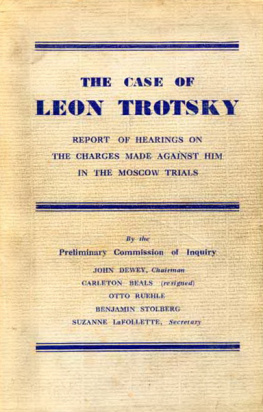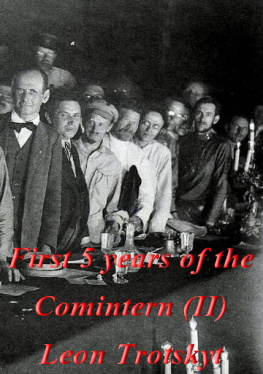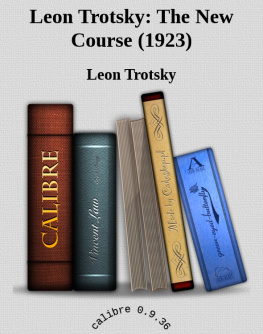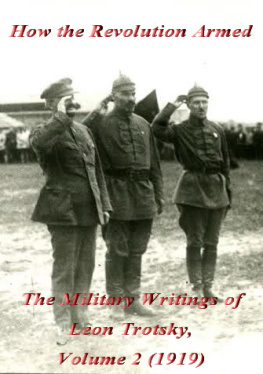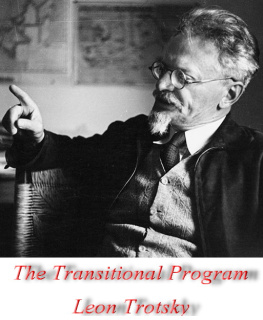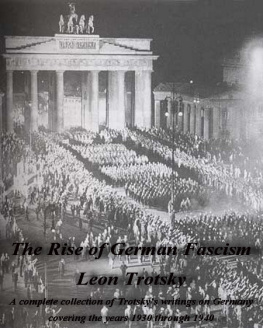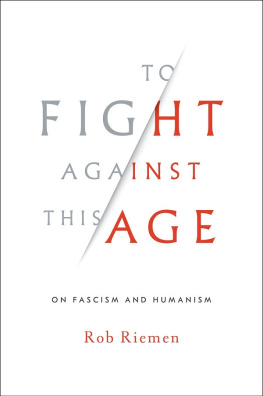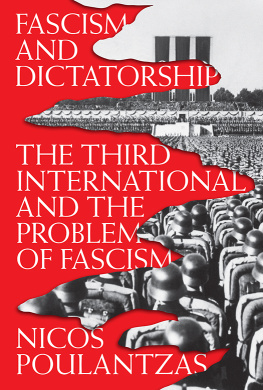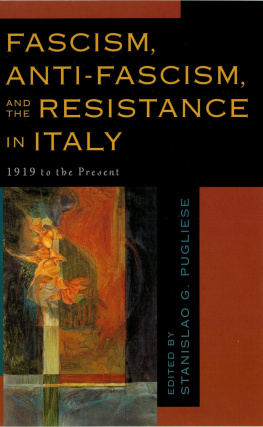Trotsky - Fascism: What it is and how to fight it
Here you can read online Trotsky - Fascism: What it is and how to fight it full text of the book (entire story) in english for free. Download pdf and epub, get meaning, cover and reviews about this ebook. year: 1944, publisher: Marxists Internet Archive, genre: Politics. Description of the work, (preface) as well as reviews are available. Best literature library LitArk.com created for fans of good reading and offers a wide selection of genres:
Romance novel
Science fiction
Adventure
Detective
Science
History
Home and family
Prose
Art
Politics
Computer
Non-fiction
Religion
Business
Children
Humor
Choose a favorite category and find really read worthwhile books. Enjoy immersion in the world of imagination, feel the emotions of the characters or learn something new for yourself, make an fascinating discovery.

Fascism: What it is and how to fight it: summary, description and annotation
We offer to read an annotation, description, summary or preface (depends on what the author of the book "Fascism: What it is and how to fight it" wrote himself). If you haven't found the necessary information about the book — write in the comments, we will try to find it.
Fascism: What it is and how to fight it — read online for free the complete book (whole text) full work
Below is the text of the book, divided by pages. System saving the place of the last page read, allows you to conveniently read the book "Fascism: What it is and how to fight it" online for free, without having to search again every time where you left off. Put a bookmark, and you can go to the page where you finished reading at any time.
Font size:
Interval:
Bookmark:
What It Is and How To Fight It
- by George Lavan Weissman
By George Lavan Weissman
L iberals and even most of those who consider themselves Marxists are guilty of using the world fascist very loosely today. They fling it around as an epithet or political swearword against right-wing figures whom they particularly despise, or against reactionaries in general.
Since WWII, the fascist label has been applied to such figures and movements as Gerald L. K. Smith, Senator Joseph McCarthy, Senator Eastland, Barry Goldwater, the Minutemen, the John Birch Society, Richard Nixon, Ronald Reagan, and George Wallace.
Now, were all these fascist, or just some? If only some, then how does one tell which are and which aren't?
Indiscriminate use of the term really reflects vagueness about its meaning. Asked to define fascism, the liberal replies in such terms as dictatorship, mass neurosis, anti-Semitism, the power of unscrupulous propaganda, the hypnotic effect of a mad-genius orator on the masses, etc. Impressionism and confusion on the part of liberals is not surprising. But Marxism's superiority consists of its ability to analyze and differentiate among social and political phenomena. that so many of those calling themselves marxists cannot define fascism any more adequately than the liberals is not wholly their fault. Whether they are aware of it or not, much of their intellectual heritage comes from the social-democratic (reformist socialist) and Stalinist movements, which dominated the left in the 1930s when fascism was scoring victory after victory. These movements not only permitted Nazism to come to power in Germany without a shot being fired against it, but they failed abysmally in understanding the nature and dynamics of fascism and the way to fight it. After fascism's triumphs, they had much to hide and so refrained from making a Marxist analysis which would, at least, have educated subsequent generations.
But there is a Marxist analysis of fascism. It was made by Leon Trotsky not as a postmortem, but during the rise of fascism. This was one of Trotsky's great contributions to Marxism. He began the task after Mussolini's victory in Italy in 1922 and brought it to a high point in the years preceding Hitler's triumph in Germany in 1933.
In his attempts to awaken the German Communist Party and the Communist International (Comintern) to the mortal danger and to rally a united-front against Nazism, Trotsky made a point-by-point critique of the policies of the social-democratic and Stalinist parties. This constitutes a compendium of almost all the mistaken, ineffective, and suicidal positions that workers' organizations can take regarding fascism, since the positions of the German parties ranged from opportunistic default and betrayal on the right (social democratic) to ultra-left abstentionism and betrayal (Stalinist).
The Communist movement was still on its ultra-left binge (the so-called Third Period) when the Nazi movement began to snowball. To the Stalinists, every capitalist party was automatically "fascist". Even more catastrophic than this disorienting of the workers was Stalin's famous dictum that, rather than being opposites, fascism and social democracy were "twins". The socialists were thereupon dubbed "social fascists" and regarded as the main enemy. Of course, there could be no united front with social-fascist organizations, and those who, like Trotsky, urged such united fronts, were also labeled social fascists and treated accordingly.
How divorced from reality the Stalinist line was may be illustrated be recalling its translation into American terms. In the 1932 elections, American Stalinists denounced Franklin Roosevelt as the fascist candidate and Norman Thomas as the social-fascist candidate. What was ludicrous as applied to US politics was tragic in Germany and Austria.
(Recently [1969], the term social fascism had begun cropping up in articles by members of the new left. Do those using it imagine that they have invented the term? Or, if they are aware of its history, are they indifferent to its connotations?)
After the Nazis came to power, the Stalinists boasted that their line had been 100 per cent correct, that Hitler could only last a few months, and that a Soviet Germany would then emerge. The time limit for this miracle was extended from three, six, to nine months, and then the idle boasts dwindled into silence. The magnitude of the defeat suffered by the working class, the special character of fascism, distinguishing it from other reactionary regimes or dictatorships, became apparent to all, and the threat to the Soviet Union or a rearmed German imperialism began to take on reality. This brought about a change in Moscow's line in 1935 and the Communist parties throughout the world thereupon zigzagged far to the right, to the right even of the social-democrats. This was their stance in the face of the spreading fascist danger in France and Spain.
The military ruin of German and Italian fascism in WWII convinced most people that fascism had been destroyed for good and was so utterly discredited that it could never again entice any followers. Events since then, particularly the emergence of new fascist groups and tendencies in almost every capitalist country,have dispelled such wishful thinking. The illusion that WWII was fought to make the world safe from fascism has gone the way of the earlier illusion that WWI was fought to make the world safe for democracy. The germ of fascism is endemic in capitalism; a crisis can raise it to epidemic proportions unless drastic countermeasures are applied.
Since forewarned is forearmed, we offer this new compilation -- a small selection from Trotsky's writings on the subject -- as a weapon for the anti-fascist arsenal.
W hat is fascism? The name originated in Italy. Were all the forms of counter-revolutionary dictatorship fascist or not (That is to say, prior to the advent of fascism in Italy)?
The former dictatorship in Spain of Primo de Rivera, 1923-30, is called a fascist dictatorship by the Comintern. Is this correct or not? We believe that it is incorrect.
The fascist movement in Italy was a spontaneous movement of large masses, with new leaders from the rank and file. It is a plebian movement in origin, directed and financed by big capitalist powers. It issued forth from the petty bourgeoisie, the slum proletariat, and even to a certain extent from the proletarian masses; Mussolini, a former socialist, is a "self-made" man arising from this movement.
Primo de Rivera was an aristocrat. He occupied a high military and bureaucratic post and was chief governor of Catalonia. he accomplished his overthrow with the aid of state and military forces. The dictatorships of Spain and Italy are two totally different forms of dictatorship. It is necessary to distinguish between them. Mussolini had difficulty in reconciling many old military institutions with the fascist militia. This problem did not exist for Primo de Rivera.
The movement in Germany is analogous mostly to the Italian. It is a mass movement, with its leaders employing a great deal of socialist demagogy. This is necessary for the creation of the mass movement.
Font size:
Interval:
Bookmark:
Similar books «Fascism: What it is and how to fight it»
Look at similar books to Fascism: What it is and how to fight it. We have selected literature similar in name and meaning in the hope of providing readers with more options to find new, interesting, not yet read works.
Discussion, reviews of the book Fascism: What it is and how to fight it and just readers' own opinions. Leave your comments, write what you think about the work, its meaning or the main characters. Specify what exactly you liked and what you didn't like, and why you think so.

